A new trend in kitchen design is gaining popularity, which is making Upper Cabinets free kitchen. This fresh and open concept provides homeowners with more creative freedom and a renewed sense of style. It eliminates crowded wall cabinets, making the kitchen feel spacious and airy. Instead, homeowners are adopting the concept of openness, allowing for more creative freedom and a renewed sense of style.
Kitchen Upper Cabinets Serve Important Purposes in Kitchen Design:
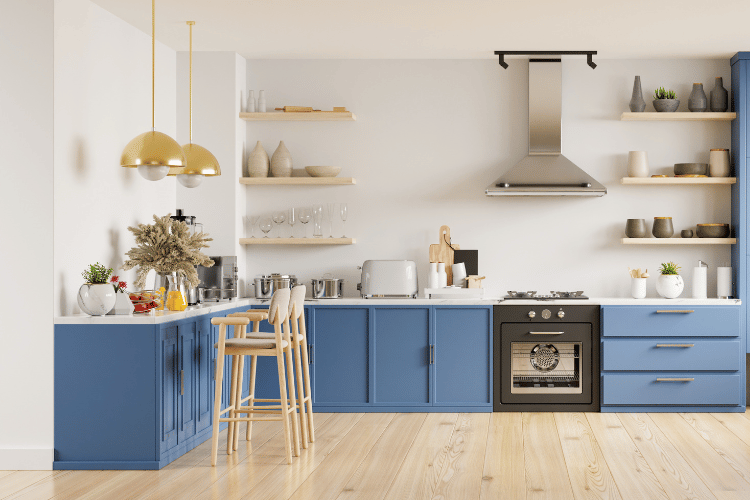
- Storage: Upper cabinets provide additional storage space for kitchen items such as dishes, glassware, cookware, and small appliances. They help keep the kitchen organized by providing designated areas to store items and minimize clutter on countertops.
- Accessibility: Placing frequently used items in upper cabinets ensures easy access and convenience during meal preparation. Items like plates, glasses, and mugs can be stored at eye level for quick retrieval.
- Protection: Upper cabinets protect items from dust, dirt, and potential damage, especially delicate or fragile items such as glassware. The cabinet doors provide a shield that helps keep stored items clean and safe.
- Design and visual appeal: Upper cabinets contribute to the overall appearance of the kitchen design. They can be customized to match the style of the kitchen. They add visual interest and complement other elements such as backsplashes or countertops.
- Concealment of less attractive items: Not all kitchen items are visually appealing or suitable for open display. Upper cabinets offer a practical solution to hide less attractive items or those not used frequently. Therefore helps in maintaining a tidy and visually pleasing kitchen appearance.
- Utilization of vertical space: Upper cabinets make efficient use of vertical space in the kitchen. By extending cabinetry to the ceiling, homeowners maximize storage capacity and use every available inch of space.
- Sound dampening: Upper cabinets can help reduce noise in the kitchen by acting as a shield between the workspace and other areas of the home. They can absorb and block some of the sounds generated during cooking or appliance use.
- Design balance and symmetry: Upper cabinets contribute to the overall design balance and symmetry of the kitchen. They help create a cohesive and balanced look when combined with lower cabinets, appliances, and other kitchen elements.
Alternatives for Kitchen Upper Cabinets
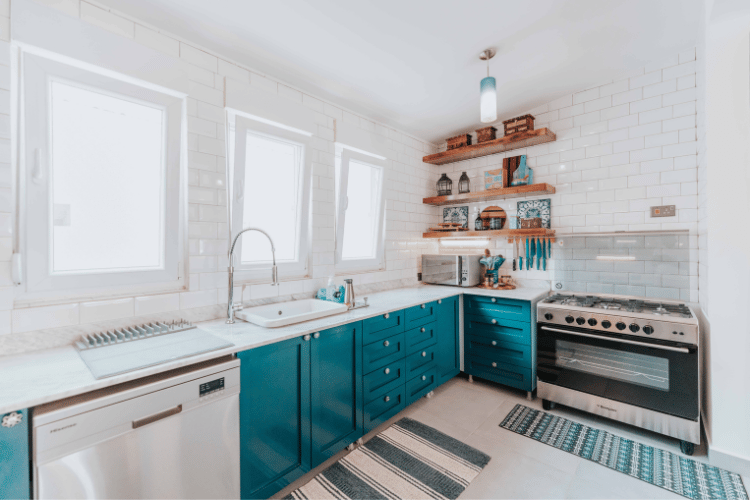
When it comes to upper cabinet-free kitchens, there are several design options that homeowners can consider. Here are some popular types:
Floating Shelves:
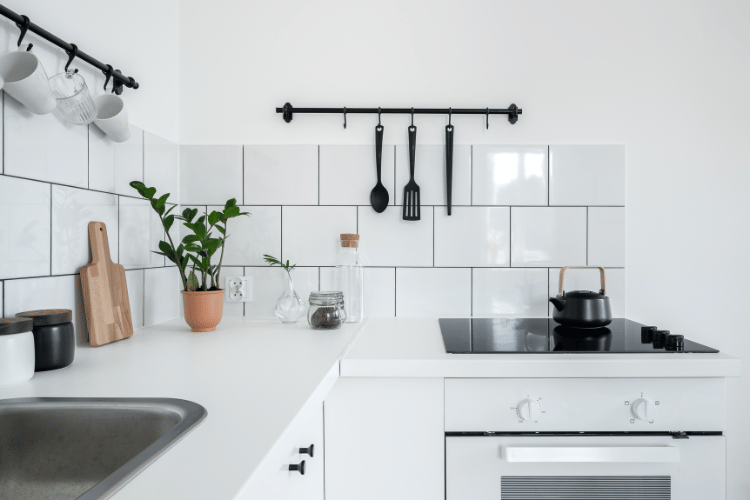
Floating shelves are mounted on the walls without any visible brackets or supports. They create a sleek and minimalist look, providing storage space while maintaining an open feel in the kitchen.
Window Shelves:
In kitchens with large windows, utilizing the space beneath the windowsill as shelves is an excellent option. It maximizes storage without blocking natural light and creates a unique and functional design feature.
Plate Racks:
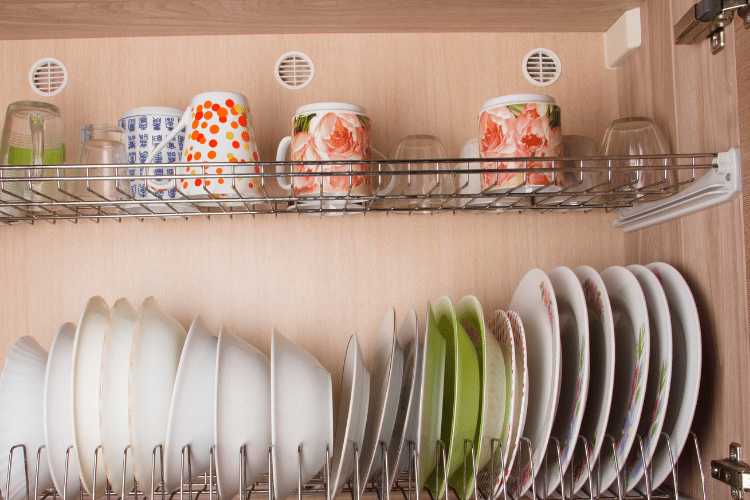
Plate racks are specially designed shelves that hold and display plates. They can be installed on the walls or integrated into kitchen islands, adding a touch of charm and elegance to the kitchen while providing practical storage for plates.
Pot Racks:

Pot racks are ceiling-mounted or wall-mounted racks specifically designed to hold and display pots and pans. They not only free up cabinet space but also serve as a decorative element, showcasing beautiful cookware.
Floor-to-Ceiling Pantries:
To make up for the lack of upper cabinets, homeowners can opt for floor-to-ceiling pantry cabinets. These tall cabinets provide ample storage space for pantry items, food storage containers, and kitchen appliances.
Wall-Mounted Storage Systems:
Wall-mounted storage systems, like modular shelving units, provide versatile storage options. Grid panels with hooks and baskets also offer flexible storage solutions for Utilizing the fullest space. Homeowners can customize the arrangement and placement of shelves and hooks to suit their specific needs.
Freestanding Furniture:

In upper cabinet-free kitchens, homeowners can use freestanding furniture pieces such as hutches, sideboards, or cabinets to offer storage and establish a focal point. Freestanding furniture pieces like hutches, sideboards, or cabinets serve dual purposes in upper cabinet-free kitchens by providing storage options and becoming eye-catching centrepieces. These pieces offer a combination of storage and decorative features, adding character to the kitchen.
Minimalist Design:

A minimalist approach characterizes some upper cabinet-free kitchens, featuring clean lines, sleek countertops, and minimalist storage solutions such as hidden cabinets or concealed drawers. Clean lines, sleek countertops, and minimalist storage solutions like hidden cabinets or concealed drawers define the aesthetic of upper cabinet-free kitchens that embrace a minimalist design approach. This design style highlights simplicity and open space.
Advantages of Kitchen Upper Cabinets Free Designs
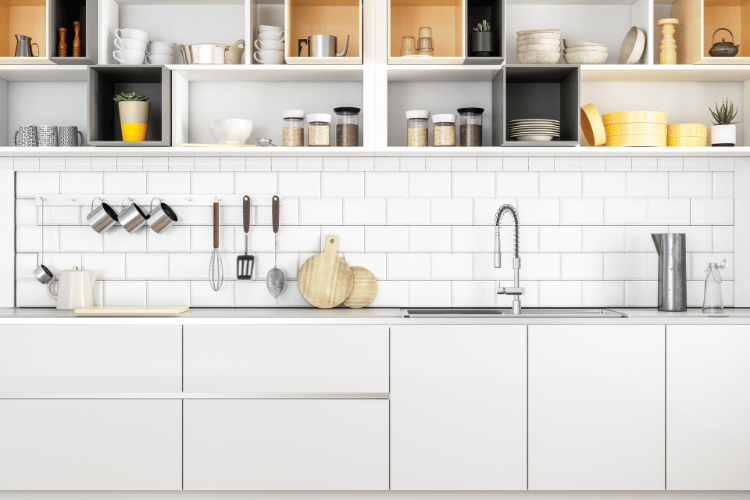
Choosing upper cabinet-free kitchens offers many advantages that make them an appealing option for homeowners.
- Increased spaciousness: Removing upper cabinets instantly opens up the kitchen, making it feel larger and more airy.
- Enhanced visual appeal: The absence of upper cabinets creates clean lines and unobstructed views, giving the kitchen a sleek and modern look.
- Improved natural light: Without upper cabinets blocking windows or light sources, more natural light can flow into the kitchen, creating a brighter and more inviting space.
- Flexibility in design: Upper cabinet-free kitchens offer more design flexibility, allowing homeowners to showcase their personal style and creativity.
- Easy access to items: Open shelving or alternative storage solutions make it easier to access frequently used items, eliminating the need to search through cabinets.
- Personalization options: With open space on the walls, homeowners can add decorative elements, artwork, or floating shelves to personalize the kitchen and display cherished items.
- Efficient storage alternatives: Upper cabinet-free kitchens often incorporate alternative storage solutions such as floor-to-ceiling pantries, built-in shelving, or kitchen islands with ample storage, maximizing storage efficiency.
- Improved organization: With open shelving or well-designed storage systems, organizing and finding items becomes easier, leading to a more efficient and organized kitchen.
- Social and family-friendly: The open layout of upper cabinet-free kitchens promotes social interaction, making it easier to engage with family members and guests while cooking or entertaining.
- Cost-effective: Removing upper cabinets can be a cost-effective solution as it eliminates the need for expensive cabinetry.
Disadvantages of Kitchen Upper Cabinets Free Designs

While upper cabinet-free kitchens offer many advantages, it’s important to consider some possible disadvantages as well. Here are a few drawbacks to keep in mind:
- Limited storage space: Removing upper cabinets means reducing the available storage space in the kitchen. This can be challenging for homeowners with a large number of kitchen items or those who require extensive storage for their cooking equipment and supplies.
- Increased visibility of clutter: Without upper cabinets to conceal items, the kitchen can appear cluttered and visually overwhelming if not properly organized. Open shelving requires careful curation and regular tidying to maintain a neat and appealing aesthetic.
- Dust and maintenance: Open shelving and alternative storage options are more exposed to dust and require regular cleaning. Kitchen items displayed on open shelves may need to be dusted more frequently, adding to the maintenance requirements of the kitchen.
- Risk of breakage: With items exposed on open shelves, there is a higher risk of accidental breakage, especially if the shelves are not securely installed or items are not properly stored. Fragile or delicate items may be vulnerable to damage in this setup.
- Difficulty in concealing less attractive items: Certain kitchen items may not be visually appealing or suitable for display, such as mismatched dishes or less attractive appliances. Without upper cabinets, it can be challenging to hide or store these items out of sight.
In summary, opting for an upper cabinet-free kitchen offers a modern and open design approach that transforms kitchen spaces. By removing upper cabinets, homeowners can enjoy the benefits of a spacious and visually pleasing environment. This includes enhanced natural light, easy access to items, and customizable storage options. However, with careful planning and organization, homeowners can create a functional and innovative kitchen design that perfectly suits their needs.


